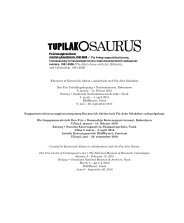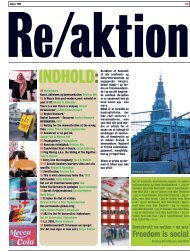tupilakosaurus - Print matters!
tupilakosaurus - Print matters!
tupilakosaurus - Print matters!
You also want an ePaper? Increase the reach of your titles
YUMPU automatically turns print PDFs into web optimized ePapers that Google loves.
LegeNde<br />
lugu, ajornanngippallu allanik oqaluttuanik<br />
paasinneriaatsinillu ilassuteqartittarlugit.<br />
Nammineq ima oqaatigaa: “Oqaluttuarpassuit<br />
ilaatinniartarpakka asseq imaannaanngitsoq<br />
kusanartorlu ersersinniarlugu.”<br />
Immikkoortortaq suliarpaalunnik oqaluttuassartalinnik<br />
imaqarpoq. Ilagivaat assilisat<br />
qalipaateqanngitsut meeraanermi arlaatigut<br />
attuumassutillit toqqaannarlugit allaffigisarsimasai<br />
– ilaatigut assip sinaa toqqaannarlugu<br />
allaffigisarsimallugu.<br />
Isumalersuineq Arkep immikkut soqutigilluinnarsimavaa.<br />
“Uagut inuiaqatigiit arlalippassuartigut<br />
assigiinngequteqartut”, taamak<br />
allassimavoq atuakkami Etnoæstetik-mi (1995),<br />
“soqutigaarput katersugaasiveqarnerup iluani<br />
saqqummersitatut ilanngutissasut. Soqutigaarput<br />
Europamut attaveqarnerput qulaajassallugu<br />
soorlu eqqumiitsuliortup eqqumiitsuliorneq<br />
sammerusuttaraa annilaangaginagu pioreersut<br />
mingutsissallugit – akerlianilli.”<br />
Assit sinaani nipit ersarissut piffinnik, piffinnillu<br />
tikitanik silallu pissusaanik telegrammitut<br />
unikkaartutut akornanni amerikarmiut<br />
nipaat tusarsaavoq. Arke pisariaqanngitsut<br />
ilanngunneq ajorpai. Nipit immineq ersarissuupput.<br />
Maluginiagassaavorlu tammaarsimaarnerpalaaq<br />
aammalu sakkutuut<br />
sungiusartarfii amerikarmiut peqatigalugit<br />
saqqummertoq. Spejdererpalaarneq sakkutuujussusermut<br />
ilassuulluni. Ulluinnarnilu sulineq,<br />
malittarisaqarlunilu iliuusissat issakatsiaarfitoqarlu<br />
timmisartoq qaartartunik imalik<br />
B-52 eqqissisimaffiup nalaani naapipput.<br />
Sorsunneqarfiunngitsup nalaani takorluukkat<br />
paatsoornarsinnaasut angissutsit<br />
saqqummertarput: Danmarkimineerannguaq<br />
nunarsuarmi, Danmarkersuaq piginnaanilissuartut,<br />
Kalaallit Nunaarannguat nalagaaffissuit<br />
akornanni, Kalaallit Nunarujussuat<br />
nassaartuiffissaq aqutassarlu … Danmarkip<br />
mittarfeqarnermut sakkussanullu atomitalinnut<br />
inatsisaa inerteqqut Kalaallit Nunaanut<br />
atuussimanngilaq. Tamannalu oqaluuserineqarpianngilaq.<br />
Ulloq mannattaaq tikillugu<br />
Danmarkip NATO-mi inissisimanera eqqartorneqanngilaq<br />
qanorlu nuna faktor 30-imik<br />
sunnerneqapilussimanera.<br />
Arkep aamma tamakkua eqqartunngilai.<br />
Akerlianik nipaanneq oqaluttippaa.<br />
THEME SECTION 6: LEGEND<br />
This section looks more closely at the<br />
play of irony in Pia Arke’s bricolages<br />
– once again with a point of departure<br />
in a specific work, namely the series<br />
Legend I-V (1999). The five fragilely<br />
monumental pictures appropiate maps<br />
of North East Greenland that were<br />
at hand. The maps are in themselves<br />
wonderfully colourful, but they have<br />
been treated with graphic powder,<br />
which makes them dark in some<br />
places, almost gloomy. In the middle of<br />
these rough landscapes (in the middle<br />
of the maps of them) shine a handful of<br />
warm yellow-toned female portraits.<br />
They come from Ittoqqortoormiit<br />
and the time just after World War<br />
II. Thus, Legend III is adorned by a<br />
youthful portrait of Arke’s mother. At<br />
first sight she and the other women<br />
seem to have tattoos on their faces.<br />
Perhaps a little like the five women<br />
in the famous Qilakitsoq mummy<br />
find, which can today be seen at the<br />
Greenland National Museum & Archives<br />
– or like the woman in Mathias<br />
Blumenthal’s painting from 1753 of<br />
The Greenlandic Woman Maria, hanging<br />
in the Ethnographic Collection at<br />
the National Museum of Denmark in<br />
Copenhagen.<br />
But on closer inspection we see<br />
that the artist has attached a piece of<br />
transparent paper strewn with place<br />
names that refer to the resourceful<br />
Europeans and Americans who took<br />
the first places in the race to give the<br />
world names: WULLF LAND (after a<br />
Swedish botanist), KANE BASSIN (after<br />
an American doctor), HUMBOLDT<br />
GLACIER (after the German natural<br />
scientist and founder of modern geography)<br />
and so on.<br />
“Greenland as construction” Arke<br />
might have titled her work, and this<br />
section would then have been given<br />
the same unambiguous title. But of<br />
course she didn’t. For Arke was great<br />
at titles. She mastered the balancing<br />
act between not giving too much and<br />
not giving too little when naming her<br />
works, not to close their interpretation,<br />
but to keep it open, so one’s brain goes<br />
into a spin when one tries to get a grip<br />
on what is going on.<br />
Arke plays with words, meanings<br />
and preconceived interpretations. Legend<br />
(in Danish: playfully). She points<br />
to the myth – about Greenland, types<br />
of peoples, folklore and all the tupilak’s<br />
curses – before Christianity reached<br />
the country. Legend. Christianity<br />
arrived, and with it the religiously<br />
edifying accounts of the exemplary<br />
lives of the saints, male and female.<br />
Legends of saints. One could go on. But<br />
the most obvious reading (Medieval<br />
Latin: “legenda” = things that are to be<br />
read) must be the legend as explanation<br />
of the signs used on a map, that is the<br />
list of the symbols’ meanings that the<br />
mapmaker provides on any decent map<br />
or chart.<br />
Arke has given her maps her own<br />
explanation taken from the local store:<br />
coffee, sugar, rice and the more domestic<br />
products flour and oats. She pursues<br />
juxtapositions that activate an ironic<br />
play of meanings, and which therefore<br />
examine the meanings to see if there<br />
might be openings or fissures, into<br />
which one could insert other narratives<br />
and interpretations: “Instead of cleansing<br />
the picture so it could become that<br />
magnificent aesthetic picture I put a lot<br />
of history on top,” as she phrased it.<br />
The section also contains a considerable<br />
number of the numerous works<br />
onto which she quite literally heaps<br />
a mass of history. Either by writing<br />
directly on the black-and-white<br />
photographs of the places where she<br />
spent her Greenlandic childhood. Or by<br />
scribbling directly on the frame.<br />
The frame as a bearer of meaning is<br />
of special interest for Arke. “We, the<br />
ethnic in various shades,” she writes in<br />
her book Ethno-Aesthetics (1995), “have<br />
an interest in bringing the museological<br />
framework into the exhibition. We have<br />
an interest in unveiling the connections<br />
leading back to Europe, in the same<br />
way as the aesthete has an interest in<br />
occupying him- or herself with art. Here<br />
you will find no fear that authentic<br />
values will be polluted, in fact, quite the<br />
contrary.”<br />
Among the voices heard on the frames<br />
– and which describe places, arrivals,<br />
weather conditions and more in an<br />
excited telegram style – we now find<br />
American voices. Arke doesn’t go into<br />
detail. She leaves that to the voices. But<br />
a general atmosphere of camps, a sense<br />
of base camps and – very faintly – boot<br />
camps makes itself felt with the presence<br />
of the Americans. The boy-scoutish<br />
shifts towards the military. Everyday<br />
activities go hand in hand with strategic<br />
tasks and the old seat board of a swing<br />
meets B-52 bombers in peacetime.<br />
The peacetime angle is part of the<br />
ironic play with ideas that have to do<br />
with size. Little Denmark in the big<br />
world, big Denmark with the right<br />
competences, tiny little Greenland<br />
among the big nations of the world,<br />
colossal Greenland to be discovered<br />
and administered and so on. Apparently<br />
Denmark’s ban on bases and<br />
nuclear weapons in peacetime did not<br />
apply to Greenland. But that wasn’t<br />
talked about so much. Nor do we talk<br />
so much today about what it means for<br />
Denmark’s role in NATO to boost its<br />
territory by a factor of 30.<br />
Arke doesn’t speak about it either.<br />
Instead she speaks about the silence.<br />
47




